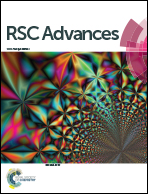Preparation and enhanced visible-light photocatalytic activity of Pancake Rocks-like WO3−x/C nanocomposite†
Abstract
The Pancake Rocks-like WO3−x/C nanocomposite was synthesized via the in situ solid state thermolysis of dedocylamine–intercalated H2W2O7 (H2W2O7/DDA), leading to the in situ production of interlayered carbon. The Pancake Rocks-like WO3−x/C nanocomposite has a high conduction band position compared to the pure WO3, which has an important influence on the photocatalytic process. Furthermore, the interlayered carbon acts as an electron channel that can transfer the photogenerated electrons from WO3−x. The visible-light response of the Pancake Rocks-like WO3−x/C nanocomposite was enhanced through the intercalation of carbon.


 Please wait while we load your content...
Please wait while we load your content...